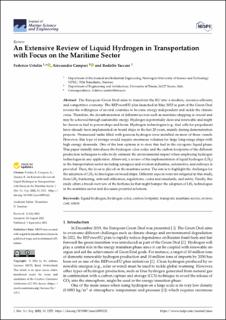| dc.description.abstract | The European Green Deal aims to transform the EU into a modern, resource-efficient, and competitive economy. The REPowerEU plan launched in May 2022 as part of the Green Deal reveals the willingness of several countries to become energy independent and tackle the climate crisis. Therefore, the decarbonization of different sectors such as maritime shipping is crucial and may be achieved through sustainable energy. Hydrogen is potentially clean and renewable and might be chosen as fuel to power ships and boats. Hydrogen technologies (e.g., fuel cells for propulsion) have already been implemented on board ships in the last 20 years, mainly during demonstration projects. Pressurized tanks filled with gaseous hydrogen were installed on most of these vessels. However, this type of storage would require enormous volumes for large long-range ships with high energy demands. One of the best options is to store this fuel in the cryogenic liquid phase. This paper initially introduces the hydrogen color codes and the carbon footprints of the different production techniques to effectively estimate the environmental impact when employing hydrogen technologies in any application. Afterward, a review of the implementation of liquid hydrogen (LH2) in the transportation sector including aerospace and aviation industries, automotive, and railways is provided. Then, the focus is placed on the maritime sector. The aim is to highlight the challenges for the adoption of LH2 technologies on board ships. Different aspects were investigated in this study, from LH2 bunkering, onboard utilization, regulations, codes and standards, and safety. Finally, this study offers a broad overview of the bottlenecks that might hamper the adoption of LH2 technologies in the maritime sector and discusses potential solutions. | en_US |

